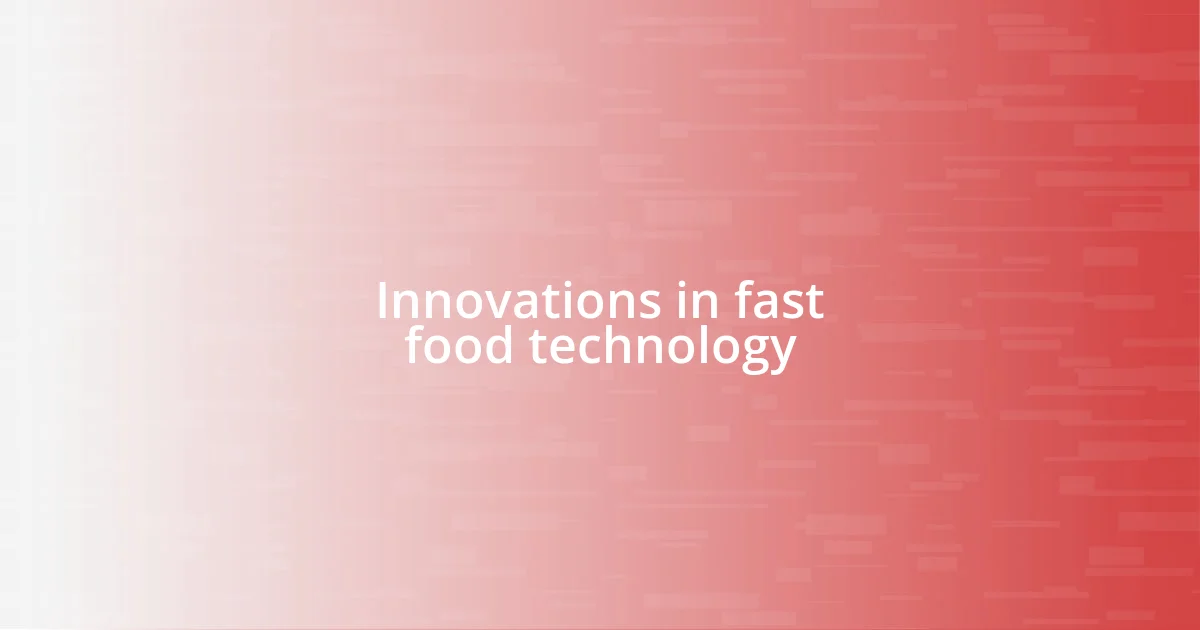Key takeaways:
- The fast food industry is adapting to consumer preferences for health, evident in the rise of plant-based options and transparency in nutritional information.
- Social media marketing significantly influences dining experiences and trends, making meals more about sharing experiences than just eating.
- Sustainability practices, such as eco-friendly packaging and local sourcing, are increasingly important to consumers, often influencing their dining choices.

Understanding fast food trends
Understanding fast food trends involves more than just knowing what’s on the menu; it’s about grasping the cultural shifts behind those choices. I remember the excitement I felt seeing plant-based burger options pop up everywhere. It made me think about how dietary preferences are shaping the fast food industry and catering to a more health-conscious consumer base.
As I watched these trends evolve, I couldn’t help but wonder—how many people are truly aware of the impact their food choices have on the environment? For example, the rise of eco-friendly packaging reflects consumers’ growing awareness of sustainability. Just last week, I was thrilled to find a fast food chain that proudly advertised its use of compostable materials, which made me appreciate their efforts even more.
Another fascinating aspect is the influence of technology on fast food trends. Remember when ordering through apps and delivery services became the norm? That shift opened up conversations about convenience and accessibility. Personally, I find it intriguing how my dining habits have changed just from a simple click on my phone—what was once a spontaneous trip to a drive-thru is now a few taps away, inviting me to consider how convenience affects our relationship with food.

Impact of health awareness
Awareness about health has reshaped the fast food industry significantly. I’ve noticed that many chains are now offering lower-calorie options and emphasizing transparency in their ingredient lists. Just the other day, while scrolling through a menu, I appreciated how clear they were about nutritional information. It felt good to know that I could make an informed choice without having to guess what went into my meal.
- Increased demand for plant-based options, catering to vegetarian and vegan consumers.
- Emphasis on nutritional content, helping consumers make healthier choices.
- Introduction of gluten-free items and allergen-friendly alternatives.
- Promotion of items with superfoods, like quinoa and kale, in the menu.
- Engaging marketing campaigns focusing on healthy eating habits and lifestyle.

Rise of plant based options
The rise of plant-based options has been quite remarkable, and I’ve personally felt this shift while dining out. My friends and I once found ourselves exploring a new diner that boasted an entirely plant-based menu. I remember being pleasantly surprised at how creative they were with ingredients. It opened my eyes to the flavors and possibilities that come from embracing a plant-based diet, proving that these options can be just as tasty—if not more so—than traditional fast food.
There’s something special about watching fast food chains expand their offerings to include plant-based meals. I recall a Saturday afternoon when I decided to try the new plant-based burger at a popular chain. The sheer joy of taking my first bite made me a believer. It was not just a replacement; it felt like an entirely new experience, showcasing how far the fast food industry has come in catering to diverse dietary needs.
The cultural impact of these plant-based options is profound. Sometimes, I see people sharing their plant-based fast food experiences on social media, and it warms my heart. It’s not just a trend; it reflects a broader understanding of food’s role in our lives. It invites conversations about sustainability and ethics, encouraging us, as consumers, to rethink our choices and how they impact the world around us.
| Traditional Fast Food Options | Plant-Based Alternatives |
|---|---|
| Beef burgers | Plant-based burgers (e.g., Beyond Meat, Impossible Burger) |
| Regular chicken nuggets | Plant-based nuggets (e.g., soy or pea protein) |
| Conventional dairy milkshakes | Non-dairy shakes (e.g., almond, oat, or coconut milk) |

Influence of social media marketing
The influence of social media marketing on fast food trends is profound and fascinating. Think about it: just the other day, I stumbled upon an Instagram reel showcasing a viral burger challenge, and I couldn’t resist the urge to check it out for myself. It amazes me how a catchy hashtag or a trendy video can spark interest in a menu item, often leading to long lines at restaurants. Who knew that a simple post could turn an ordinary meal into an experience everyone wants to share?
From what I’ve seen, fast food chains harness social media to create engaging campaigns that resonate with younger audiences. I recall a time when a popular chain released a limited-edition burger, and within hours, social media was buzzing with reviews and pictures. This not only generated excitement but also fostered a sense of community among those eager to share their take. Doesn’t it feel like we’re all part of a larger conversation about food now?
With influencers and food bloggers dominating our feeds, the landscape of fast food marketing has changed dramatically. I’ve noticed that many of my friends are influenced by these social media personalities when choosing where to eat. They’re not just after a meal anymore; they’re seeking an Instagram-worthy experience. This shift has encouraged brands to invest even more in their online presence. Have you ever made a dining decision based on a beautifully curated post? I know I have, and it highlights the power social media holds in shaping our preferences.

Innovations in fast food technology
The fast food industry is witnessing some amazing technological innovations that are changing the dining experience. When I first tried ordering through a kiosk, I felt a sense of empowerment; I could customize my order without feeling rushed by a cashier. It was a refreshing change that made me think about how technology enhances our choices and personalizes our meals.
One remarkable advancement is the use of mobile apps for ordering and delivery. Just last week, after a busy day, I used a popular fast food app to order dinner. I was pleasantly surprised at how easy it was to select my favorite items and even apply special deals. It felt like having my own personal assistant, making it clear that convenience is now paramount in our dining preferences.
Then, I learned about AI-driven systems that predict what customers want based on their past orders. Can you imagine that? It was almost eerie when my local chain started suggesting my go-to order the moment I opened their app. This not only demonstrates how technology is becoming an integral part of fast food but also raises questions about personalization versus privacy. As we embrace these changes, what does it mean for our connection to food and the industry? These innovations truly reflect a fascinating evolution in how we engage with fast food.

Consumer preference for sustainability
Consumer preference for sustainability is increasingly shaping the landscape of fast food. Just the other day, I found myself torn between two chains, and the decision came down to their environmental practices. One brand was flaunting its commitment to reducing plastic waste, while the other remained silent on the issue. It struck me how pivotal these values can be in influencing our dining choices.
As I chatted with friends about their favorite places to eat, sustainability kept popping up in our conversations. It felt refreshing to see us prioritizing eco-friendly packaging and sourcing local ingredients. I even recall a time when a friend refused to buy from a popular chain because they’d read about its impact on deforestation. Isn’t it interesting how our choices can ripple out and promote positive change?
I’ve noticed that customers are becoming more vocal about their preferences, tapping into their purchasing power. Imagine walking into a restaurant and seeing a sign that reads, “We are 100% carbon-neutral”; it gives you a little thrill, doesn’t it? Knowing that I’m supporting a brand with ethical practices brings a sense of satisfaction. When sustainability becomes a core aspect of a brand’s identity, it transforms the dining experience into something much more meaningful for consumers like us.















